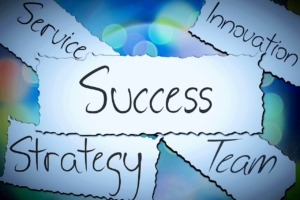Improving Your Odds For A Successful Manufacturing Workflow Strategy
By David Shaffer
When it comes to succeeding with manufacturing workflow, we are drowning in data but starved for wisdom.
That thought was first put forth by futurist John Naisbitt 40 years ago in his classic book Megatrends. Naisbitt the futurist was indeed a prophet.
His prophecy is true because today even with the ever-expanding use of technology, there is an overabundance of data. The challenge is to disseminate that data into information that can be acted upon to achieve the organization’s mission.
The overall mission and foundation of business today, as it was 40 years ago and undoubtedly will be true 40 years hence, is to maximize customer service. Today this is also referred to as the customer experience.
Great business thinkers like the late Peter Drucker said that without customers, there is no business. Giving the customers what they want, when they want it and how they want it is an ongoing challenge. Simply put, keeping the customer satisfied requires improved manufacturing workflow.
Because improving your manufacturing workflow is about keeping the customer satisfied, the best manufacturers are obsessed with it. These organization’s want to make themselves as easy as possible to work with from a supply chain, distribution and services standpoint. The good news is applications including Enterprise Resource Planning (ERP) have greatly improved manufacturing workflow.
However, almost daily you can read or hear of information systems like ERP not fulfilling manufacturing workflow expectations established at the time of acquisition. In fact, despite the most diligent efforts in defining requirements, evaluating options and selecting systems, the probability of higher-than-expected investments and system implementation issues are extremely high.
If it sounds like the odds are stacked against you, there are ways to improve your odds. ERP needs to be seen as an investment, rather than an expense, and therefore you must find ways to maximize the return on investment (ROI).
How To Improve ROI
Improving your manufacturing workplace is a bet, a gamble, a wager. Author Damon Runyon once said: “The race is not always to the swift nor the battle to the strong, but that’s the way to bet.”
No business plans to lose its bet on ERP. It is fair to assume that all participants in the implementation of technology are focused upon improved manufacturing workflow results for their individual and collective departments. The aggregate of these improved results should be focused on, and result in, improved results for the company as a whole.
Specifically, a concise definition of measuring improved results as a positive gain in the implementation of technology. If there is nothing to gain then there is obviously no reason to change.
If you want the biggest gain, bet on quality. To all organizations, quality is what is expected. To that end, in the absence of standard operating procedures, the result is variation in process and by definition; variation is the enemy of quality. By determining the least wasteful method of performing a task, quality is improved, cost is reduced and on-time delivery is the final result. By performing a task the same way each time assures consistency and eliminates variation.
As workflows are identified and the standard operating procedures are put in place, the success of these procedures will be directly determined by how effective an organization is at answering the following questions:
• What are the required inputs?
• How were you trained?
• What do you do?
• How do you know your output is good?
• What feedback do you receive?
• Who are your customers?
• What keeps you from doing error-free work?
• What can be done to make your job easier?
• What would you change as the manager?
It is hopefully fair to assume that all employees want to do a good job and would rather do an activity right the first time and not be faced with rework or quality issues. Standard operating procedures, as information or product, are passed from one group to another allowing for consistency in both input and output, resulting in improved quality and happy customers. That is a winning parlay.
Those Pesky Competitors
For a significant number of businesses however, changes are dictated externally by competition, customers, and vendors and for publicly traded companies, possibly the shareholders. This external pressure, when coupled with potentially internal conflicting goals tends to increase anxiety levels and can further contribute to poor system selection and/or utilization. How often is it heard that if we don’t change we will lose? The Internet and e-commerce are recent examples of technology forcing many businesses to react.
One of the ways businesses have tried to deal with change and the expected pressures is through strategic planning. When done correctly, and shared appropriately throughout the organization, the strategic plan becomes a roadmap and a source of reference throughout the year. By establishing a Target Operating Model (TOM) that reflects the strategic plan, the selection of the appropriate ERP can be measured against its alignment with the TOM along with value derived.
Procedures And Policies Are Linked To ROI
It is assumed that the procedures and policies associated with a new system will be integrated as part of the implementation process. Vendors of technology and software will do their best to provide the appropriate operational training however are not generally in the business of assuring that the organizational infrastructure can absorb the change. That is left to the management and implementation team.
Recognizing that a new system carries risk as well as rewards, the management team is functioning under its’ own level of pressure and may not be the best in soothing the concerns, issues and change being felt by the employees. The good intentions associated with the new system may indeed be counterproductive without the corresponding balancing of the attitudes, goals, objectives and concerns of the people that comprise the organization.
Implementing The Strategy
 Regardless of the status of the current information technology, that is utilizing an existing system or entering into the selection process of a new one, it is essential that the TOM and value to be derived are clearly defined. That is, just how will we as an organization measure the ERP value and, equally important, how will our customers measure us to decide if we are in fact successful in implementing our strategy. In addition to this measurement is the strategic plan. It must be reflective of where we want the business to be and how we will measure our success.
Regardless of the status of the current information technology, that is utilizing an existing system or entering into the selection process of a new one, it is essential that the TOM and value to be derived are clearly defined. That is, just how will we as an organization measure the ERP value and, equally important, how will our customers measure us to decide if we are in fact successful in implementing our strategy. In addition to this measurement is the strategic plan. It must be reflective of where we want the business to be and how we will measure our success.
Finally, the integration of technology and infrastructure are essential to maintaining the balance of maximizing customer service. We must place equal emphasis on understanding and implementing positive attitude as we are in implementing technology.
Defining and achieving improved results is critical to the on-going success of most businesses. To invest hundreds of thousands of dollars in technology and systems without recognizing that tools are only as good as the operator is a formula for disappointment. It has been said that the majority.
Monitor And Communicate Progress
Many organizations struggle with the implementation of key initiatives; accountability is frequently a major stumbling block. By assigning Project Managers and the consistent use of project chartering, project plans can be well defined, resourced and monitored. The aggregate results of the charters collectively address the implementation of defined key initiatives. It is customary that on a weekly basis, each Project Manager reports the status of their charter so that combined project plans are managed by a single source. That is, for quality and consistency the overall progress of the initiatives is maintained in a central repository accessible to the entire management & leadership team.
There are many ways to distill strategic planning into execution. Chartering is a great way to focus on execution while creating accountability & buy-in throughout the process.
If you are open to a conversation about improving manufacturing workflow or how our in-depth work style and personality assessment could help your team, including pricing and the science behind the tests, please contact us at 310-453-6556, extension 403.
If you would like additional information on this topic or others, please contact your Human Resources department or Lighthouse Consulting Services LLC, Santa Monica, CA, (310) 453-6556, dana@lighthouseconsulting.com & our website: www.lighthouseconsulting.com.
Permission is needed from Lighthouse Consulting Services, LLC to reproduce any portion provided in this article. © 2021
David Shaffer, Senior Consultant with Lighthouse Consulting Services, LLC, is recognized for his ability to effectively integrate all aspects of business including financial management, information systems, infrastructure, sales management, sales strategies and operations. David assists companies from executive strategic planning through operational and business process improvement opportunities to the selection and integration of management information systems solutions. His range of company support includes start up through Fortune 500.
Lighthouse Consulting Services, LLC provides a variety of services, including in-depth work style & personality assessments for new hires & staff development. LCS can test in 19 different languages, provide domestic and international interpersonal coaching and offer a variety of workshops – team building, interpersonal communication, stress and time management, leadership training as well as our full-service Business Consulting Division. To order the books, Cracking the Personality Code, Cracking the Business Code, and Cracking the High-Performance Team Code, please go to: www.lighthouseconsulting.com.







